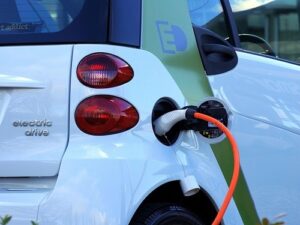Tech News : New Graphene-Based Batteries Could Be Fireproof & Safer
Los Angeles based Nanotech Energy claims to have developed a fireproof, graphene-based lithium-ion battery that could be safer for Electric Vehicles.
What Is Graphene?
Extracted from graphite, graphene is a single layer (monolayer) of carbon atoms, tightly bound in a two-dimensional, hexagonal honeycomb lattice nanostructure. First observed through electron microscopes in 1962, it was re-discovered in 2004 (although Nanotech says 2002). Graphene has exceptionally high tensile strength – 10 times that of steel, electrical conductivity, transparency, is the thinnest two-dimensional material in the world, and is the second-strongest material in the world (to Borophene).
What Causes Fires With Traditional Lithium-Ion Batteries?
Volume changes (expansion) of lithium-ion battery electrodes during charge and discharge can cause an internal short circuit, which can lead to a fire. Also, lithium-ion batteries can catch fire if they have been improperly manufactured or damaged, or if the software that operates the battery isn’t designed correctly. Lithium-ion batteries can sometimes also simply overheat during charging.
In the case of using lithium-ion batteries in EV’s, the use of organic liquid electrolytes (the battery’s most flammable component), which can be volatile and flammable when operating at high temperatures can increase the fire risk e.g., if a car-crash causes a chemical leakage.
How Is A Graphene-Based Battery Different?
The new graphene-based battery from Nanotech is reported to be different because:
– It has graphene electrodes i.e., the positive (cathode) and negative (anode) terminals. This helps the battery to withstand its volume changes during charge and discharge, thereby reducing the potential fire risk. Also, with graphene being a highly effective conductor of electricity, it can help the battery to keep a lower internal resistance and temperature, thereby helping to prevent overheating during charging.
– It uses a non-flammable, stable, and inexpensive proprietary electrolyte solution, called Organolyte™. A non-flammable electrolyte means a dramatically reduced fire risk.
– It has a new proprietary separator. The graphene battery electrodes must be separated by a material through which the ions transfer. Instead of using a typical polyolefin separator Nanotech Energy has developed a new separator material that improves stability and makes the battery safer.
Performance
In terms of performance, Nanotech reports that the battery retains more than 80 percent of its rated capacity through 1,400 cycles and can charge “18 times faster than anything that is currently available on the market”. The battery is also reported to be able to maintain performance at extreme temperatures (-40 to 140 degrees F), hold charge at temperatures as high as 350 degrees, and won’t catch fire if damaged with a nail or heated to more than 1,300 degrees.
Easy To Manufacture And Better For The Environment.
Other reported benefits of the new battery are that it doesn’t require exotic materials and can be relatively easily manufactured on existing equipment in various form factors (cylindrical, pouch, etc.). Also, Nanotech says that using graphene-based batteries could help develop more cost-efficient, environmentally friendly personal electronic devices to create a more efficient way to harness renewable energy.
What Does This Mean For Your Business?
EV’s are the way forward for domestic and commercial transport, but one of the big challenges that EV manufactures have faced is developing a battery that requires infrequent charging, charges very quickly, is durable, can go a long way on a charge, and is safe. This new graphene-based battery certainly appears to address the safety, fast charging and durability issues, and the fact that it is relatively easy to manufacture using existing equipment (keeping costs down) is also a big bonus. This discovery could go some way to helping push the EV market forward if widely adopted, although initial production looks set to concentrate on the consumer electronics market rather than electric vehicles pending more testing time. This means that these batteries may not go into big commercial production for another year, and there are still other EV challenges to overcome, such as meeting the charging network demand.

Share This!
MICROSOFT OFFICE 365
YOUR COMPLETE OFFICE IN THE CLOUD
Bringing together everyone's favourite productivity tools with the benefits of cloud-based communication and collaboration, Microsoft have developed a platform that is both technically & commercially-sound for businesses of any shape.
